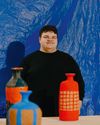Master makers The high craft and impossible detail of Chanel’s fashion collections is down to a series of unique métiers d’art workshops. We take a sew-and-tell tour

It was mid-December, a week after Chanel’s Egyptian-themed Métiers d’Art show in New York, and the artisan workshops were already back at full speed, preparing for the couture shows in January. In ateliers around Paris and beyond, people toiled in silent concentration, repeating the same gestures on feathers or buttons or fabrics or beads that their predecessors practised for generations, striving to create objects of wonder and surprise.
Paris once counted thousands of these workshops, crafting embroidery, hats, gloves, shoes, jewels and more by hand. Only a few have stood the test of time. Coco Chanel collaborated regularly with several of them, and when Karl Lagerfeld arrived at Chanel in 1983, he strengthened the connection.
Since then, the house has acquired 26 métiers d’art workshops, run by a subsidiary called Paraffection. Most are French, though they include a cashmere specialist in Scotland and a leather tannery in Spain. ‘Chanel would never have been what it is without them,’ says the house’s fashion president, Bruno Pavlovsky. ‘They are part of the DNA of the brand and one of our strongest assets.’ He explains that many of their acquisitions were financially sound, yet unsure about the future, especially those that lacked a succession plan. By picking up the workshops it considers indispensable, Chanel ensures their future and its own. Together, Pavlovsky says, they are building a ‘strong, supportive creative process’. So while other houses invest in crocodile farms, Chanel turns to Atelier Montex to create ‘python’ from embroidered paillettes that’s even more precious than the real thing.
この記事は Wallpaper の March 2019 版に掲載されています。
7 日間の Magzter GOLD 無料トライアルを開始して、何千もの厳選されたプレミアム ストーリー、9,000 以上の雑誌や新聞にアクセスしてください。
すでに購読者です ? サインイン
この記事は Wallpaper の March 2019 版に掲載されています。
7 日間の Magzter GOLD 無料トライアルを開始して、何千もの厳選されたプレミアム ストーリー、9,000 以上の雑誌や新聞にアクセスしてください。
すでに購読者です? サインイン

COOL RUNNINGS
Palace founder Lev Tanju is bringing his own unexpected brand of weirdness and love of eclectic mash-ups to Fila's new contemporary line

LIVING COLOUR
Mexico's San Miguel de Allende is home to a bold young crowd of talent that's thriving off the city's brightly-hued heritage

STARS ASCENDING
In a rapidly changing world, the route designers take to discover their calling is increasingly circuitous. We profile ten creatives forging their own paths to success

SUITE DREAMS
Cathay Pacific’s new aircraft interiors turn the inflight experience into an art form, upgrading the business-class cabin for the next generation of flyers

Brutal harmony
The Escheresque Italian villa designed by Fausto Bontempi for sculptor Claudio Caffetto

LOCAL HERO
London studio Holloway Li’s recent makeover of Polish hotel Puro Poznan is right up our street

STAR TURNS
An exhibition at Louvre Abu Dhabi unveils the stellar shortlist for this year's Richard Mille Art Prize

SCREEN GEM
A multifaceted residence in Beverly Hills puts the beauty of potentiality in the frame

SOFT SPOT
We've taken a shine to Bottega Veneta's collaboration with Flos on a special edition of a Gino Sarfatti lamp

Between the lines
Frequently drawing comparisons with Francis Bacon, painter George Rouy is gaining peer points for his use of classic techniques to distort the human form